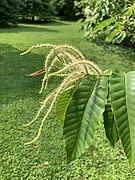Comments
provided by eFloras
Castanea henryi var. omeiensis W. P. Fang (Acta Phytotax. Sin. 9: 307. 1964) has stellate tomentose hairs on the young leaf blades and 1-3 nuts per cupule, and is probably not a variety of C. henryi but rather a hybrid between C. henryi and C. mollissima.
- license
- cc-by-nc-sa-3.0
- copyright
- Missouri Botanical Garden, 4344 Shaw Boulevard, St. Louis, MO, 63110 USA
Description
provided by eFloras
Trees to 30 m tall. Petiole 1-2.5 cm; leaf blade oblong-ovate, oblong-lanceolate, or lanceolate, 10-23 cm, abaxially covered with yellowish brown scalelike glands and sparsely pilose along veins when young, glabrescent, base rounded to broadly cuneate but narrowly cuneate when young, margin with bristlelike teeth 2-4 mm, apex long acuminate. Male inflorescences 5-16 cm. Female flowers 1(-3) per cupule. Cupules on a short spike, 2.5-3.5 cm in diam. including bracts, covered with slightly pubescent spinelike bracts. Nut 1 per cupule, globose-ovoid, 1.5-2 cm, longer than wide. Fl. May-Jul, fr. Sep-Oct.
- license
- cc-by-nc-sa-3.0
- copyright
- Missouri Botanical Garden, 4344 Shaw Boulevard, St. Louis, MO, 63110 USA
Distribution
provided by eFloras
Anhui, Fujian, Guangdong, Guangxi, Guizhou, Henan, Hubei, Hunan, Jiangsu, Jiangxi, Shaanxi, Sichuan, Yunnan, Zhejiang
- license
- cc-by-nc-sa-3.0
- copyright
- Missouri Botanical Garden, 4344 Shaw Boulevard, St. Louis, MO, 63110 USA
Habitat
provided by eFloras
* Mixed mesophytic forests on mountain slopes; 100-1800 m.
- license
- cc-by-nc-sa-3.0
- copyright
- Missouri Botanical Garden, 4344 Shaw Boulevard, St. Louis, MO, 63110 USA
Synonym
provided by eFloras
Castanopsis henryi Skan in F. B. Forbes & Hemsley, J. Linn. Soc., Bot. 26: 523. 1899; Castanea sativa Miller var. acuminatissima Seemen; C. vilmoriniana Dode.
- license
- cc-by-nc-sa-3.0
- copyright
- Missouri Botanical Garden, 4344 Shaw Boulevard, St. Louis, MO, 63110 USA
Castanea henryi
provided by wikipedia EN
Castanea henryi, Henry chestnut, Henry's chestnut, or Chinese chinquapin (a name it shares with Castanea seguinii), pearl chestnut, and in Chinese: 锥栗, zhui li, is a species of chestnut native to south-central and southeast China.[2] A tree reaching 30 m, it is a source of good timber, but has smaller nuts than its size might suggest. Like its close relative Castanea mollissima (Chinese chestnut) it is widely cultivated in China, and quite a few varieties have been developed in recent times.[3]
References
-
^ C.S.Sargent, Pl. Wilson. 3: 196 (1916)
-
^ a b "Castanea henryi (Skan) Rehder & E.H.Wilson". Plants of the World Online. Board of Trustees of the Royal Botanic Gardens, Kew. 2017. Retrieved 28 August 2020.
-
^ Li, Ying-Lin; Gu, Guang-Shi; Wu, Jun-Jian; Liu, Bin; Ye, Shu-Tao; Chen, Hui; Chen, Shi-Pin; Li, Yu (2020). "The complete chloroplast genome sequence of a Castanea henryi cultivar". Mitochondrial DNA Part B. 5 (1): 180–181. doi:10.1080/23802359.2019.1698376. PMC 7748877. PMID 33366476. S2CID 212796769.

- license
- cc-by-sa-3.0
- copyright
- Wikipedia authors and editors
Castanea henryi: Brief Summary
provided by wikipedia EN
Castanea henryi, Henry chestnut, Henry's chestnut, or Chinese chinquapin (a name it shares with Castanea seguinii), pearl chestnut, and in Chinese: 锥栗, zhui li, is a species of chestnut native to south-central and southeast China. A tree reaching 30 m, it is a source of good timber, but has smaller nuts than its size might suggest. Like its close relative Castanea mollissima (Chinese chestnut) it is widely cultivated in China, and quite a few varieties have been developed in recent times.

Flowers

Nuts
- license
- cc-by-sa-3.0
- copyright
- Wikipedia authors and editors



